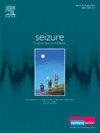Early point-of-care EEG in acute stroke: Prevalence and predictive factors of early post-stroke status epilepticus (e-PSSE)
IF 2.8
3区 医学
Q2 CLINICAL NEUROLOGY
引用次数: 0
Abstract
Purpose
Status epilepticus (SE) is a severe complication of acute stroke (AS), with an incidence of approximately 1.5 %. This study aimed to investigate the prevalence of early post-stroke status epilepticus (e-PSSE) in a real-world stroke cohort using point-of-care EEG within the first 72 h after admission and identify the clinical and laboratory factors associated with its onset during the acute phase.
Methods
Clinical, laboratory and radiological data of 647 consecutive patients with AS assessed with point-of-care EEG were retrospectively analyzed. EEG was evaluated for the diagnosis of e-PSSE according to the International Federation of Clinical Neurophysiology criteria. Data of AS patients with PSSE were compared with those without PSSE. Multivariate logistic regression analysis was conducted to identify factors associated with the onset of PSSE.
Results
The median age of the cohort was 78 (68–83) and the median NIHSS at admission was 7 (2–11). Early PSSE was found in 27 (4.2 %) of 647 included patients. Multivariate analysis showed that female sex (OR=1.039, p = 0.011), chronic kidney disease (OR=1.052, p = 0.018), hemorrhagic stroke (OR=1.075, p < 0.001), a higher neutrophil to lymphocyte ratio (NLR) (OR=1.005, p = 0.001) and NIHSS at admission (OR=1.004, p = 0.002) were significantly associated with the onset of PSSE.
Conclusion
This study highlights the critical role of early EEG assessment in detecting e-PSSE, with an incidence of 4.2 %. Moreover, our findings identify female sex, a history of CKD, higher NIHSS scores, hemorrhagic stroke, and the NLR as independent predictors of PSSE in the acute phase.
急性卒中早期即时脑电图:卒中后早期癫痫持续状态(e-PSSE)的患病率及预测因素
目的癫痫持续状态(SE)是急性卒中(AS)的严重并发症,发生率约为1.5%。本研究旨在利用入院后72小时的即时脑电图(EEG)调查现实世界卒中队列中早期卒中后癫痫持续状态(e-PSSE)的患病率,并确定与急性期发作相关的临床和实验室因素。方法回顾性分析647例AS患者的临床、实验室及影像学资料。根据国际临床神经生理学联合会的标准评估脑电图诊断e-PSSE。将合并PSSE的AS患者与未合并PSSE的AS患者的数据进行比较。进行多因素logistic回归分析以确定与PSSE发病相关的因素。结果队列患者年龄中位数为78(68 ~ 83),入院时NIHSS中位数为7(2 ~ 11)。647例患者中有27例(4.2%)发现早期PSSE。多因素分析显示,女性(OR=1.039, p = 0.011)、慢性肾脏疾病(OR=1.052, p = 0.018)、出血性卒中(OR=1.075, p < 0.001)、入院时中性粒细胞与淋巴细胞比值(NLR)升高(OR=1.005, p = 0.001)和NIHSS (OR=1.004, p = 0.002)与PSSE的发生有显著相关性。结论早期脑电图评估对发现e-PSSE具有重要作用,其发生率为4.2%。此外,我们的研究结果表明,女性、CKD病史、较高的NIHSS评分、出血性卒中和NLR是急性期PSSE的独立预测因素。
本文章由计算机程序翻译,如有差异,请以英文原文为准。
求助全文
约1分钟内获得全文
求助全文
来源期刊

Seizure-European Journal of Epilepsy
医学-临床神经学
CiteScore
5.60
自引率
6.70%
发文量
231
审稿时长
34 days
期刊介绍:
Seizure - European Journal of Epilepsy is an international journal owned by Epilepsy Action (the largest member led epilepsy organisation in the UK). It provides a forum for papers on all topics related to epilepsy and seizure disorders.
 求助内容:
求助内容: 应助结果提醒方式:
应助结果提醒方式:


